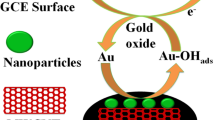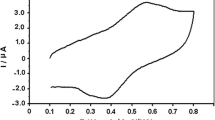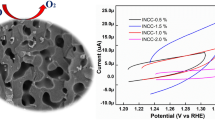Abstract
FeIII-substituted phosphorous heteropolytungstate anion PW11O39FeIII(H2O)4− (PW11Fe) is an excellent electrocatalyst for single electron reduction in aqueous medium. How to immobilize it on an electrode is important for practical applications and has been receiving one’s efforts. The paper reports a novel crystal-modified electrode (CME) Bu4NPW11Fe/C, which was prepared by immobilizing the tetrabutylammonium salt of PW11Fe (Bu4NPW11Fe) on the surface of a graphite electrode using a simple hydrothermal process. After characterization by infrared spectroscopy (IR), X-ray diffraction (XRD), scanning electron microscopy (SEM), transmission electron microscopy (TEM) etc., the electrochemical behavior and electrocatalytic activity towards H2O2 reduction of this CME were studied using the electrochemical methods of cyclic voltammetry (CV) and electrochemical impedance spectroscopy (EIS). It was found that the Bu4NPW11Fe crystals grew on the surface of the graphite electrode in the form of polycrystals such as cube, dodecahedron, and rod shape. The size of the crystalline particles varied from 0.7 to 10.4 μm. The as-prepared CME still retained the electrochemical property of PW11Fe in homogeneous solution. More importantly, it exhibited a better electrocatalytic performance for H2O2 reduction than the modified electrode PW11Fe/CS/C reported previously, prepared by a sol-gel process using chitosan (CS) as an adsorbent. Thus, this research provides a simple and convenient strategy to prepare free-adsorbent and free-crosslinking agent-modified electrodes based on polyoxometalates.










Similar content being viewed by others
References
Wang CT, Hua YJ, Li GR, Tong YX, Li YG (2008) Indirect cathodic electrocatalytic degradation of dimethylphthalate with PW11O39Fe(III)(H2O)4− and H2O2 in neutral aqueous medium. Electrochim Acta 53:5100–5105
Wang CT, Hua YJ, Li GR, Tong YX (2010) A novel electro-Fenton-like system using PW11O39Fe(III)(H2O)4− as an electrocatalyst for wastewater treatment. Electrochim Acta 55:6755–6760
Rong CY, Pope MT (1992) Lacunary polyoxometalate anions are π-acceptor ligands. Characterization of some tungstoruthenate (II,III,IV,V) heteropolyanions and their atom-transfer reactivity. J Am Chem Soc 114:2932–2938
Rong CY, Anson FC (1996) Spontaneous adsorption of heteropolytungstates and heteropolymolybdates on the surfaces of solid electrodes and the electrocatalytic activity of the adsorbed anions. Inorg Chim Acta 242:11–16
Gaspar S, Muresan L, Patrut A, Popescu IC (1999) PFeW11-doped polymer film modified electrodes and their electrocatalytic activity for H2O2 reduction. Anal Chim Acta 385:111–117
Fabre B, Bidan G (1997) Electrocatalytic behaviour of an electrode coated with a nitrite-sensitive layer based upon an iron-substituted heteropolytungstate doped poly (N-methylpyrrole). J Chem Soc Faraday Trans 93:591–601
Fernandes DM, Carapuça HM, Brett CMA, Cavaleiro AMV (2010) Electrochemical behaviour of self-assembly multilayer films based on iron-substituted α-Keggin polyoxotungstates. Thin Solid Films 518:5881–5888
Hua YJ, Wang CT, Duan H, Xu QZ, Peng T, Yu D, Xu XN, Liu XY (2011) Fabrication, characterization and electrocatalytic properties of a solid modified electrode based on PW11O39Fe(III)(H2O)4− and chitosan. Electrochim Acta 58:99–104
Carapuca HM, Balula MS, Fonseca AP, Cavaleiro AMV (2006) Electrochemical characterization of glassy carbon electrodes modified with hybrid inorganic-organic single-layer of α-Keggin type polyoxotungstates. J Solid State Electrochem 10:10–17
Brevard C, Schimp R, Tourné GF, Tourné CM (1983) Tungsten-183 NMR: a complete and unequivocal assignment of the tungsten-tungsten connectivities in heteropolytungstates via two-dimensional 183W NMR techniques. J Am Chem Soc 105:7059–7063
Zonnevijlle F, Tourné CM, Tourné GF (1982) Preparation and characterization of iron(III)-and rhodium(III)-containing heteropolytungstates. Identification of novel oxo-bridged iron(III) dimers. Inorg Chem 21:2751–2757
Pope MT (1983) Heteropoly and Isopoly Oxometalates. Springer Verlag, Berlin
Wang EB, Hu CW, Xu L (1998) Introduction of polyacid chemistry. Chemical Industry Press, Beijing
Wang CT, Hua YJ, Liu XL, Wu CY, Wang HH (2012) Visible photocatalytic degradation of rhodamine B using Keggin-type Cr(III)-substituted heteropolyanion PW11O39Cr(III)(H2O)4−. Acta Chim Sin 70:399–404
Hua YJ, Chen GL, Xu XN, Zou XM, Liu JY, Wang B, Zhao ZM, Chen Y, Wang CT, Liu XY (2014) Comparative study of homogeneous and heterogeneous photocatalytic degradation of RhB under visible light irradiation with Keggin-type manganese-substituted catalysts. J Phys Chem C 118:8877–8884
Zou XM, Chen QS, Ke XX, Lei Q, Zhao ZM, Liu XL, Chen Y, Hua YJ, Wang CT (2015) PW11Cu/TiO2 film photocatalyst: preparation and visible photocatalytic performance. Chinese J Inorg Chem 31:2037–2043
Zou XM, Chen Y, Zhu XW, Liu GP, Guo XW, Lei Q, Ke XX, Li SX, Hua YJ, Wang CT (2016) Preparation of the Keggin type chromium substituted phosphotungstates/titanium dioxide nano film and its visible photocatalytic performance. Chinese J Appl Chem 33:320–329
Toth JE, Anson FC (1988) Electrochemical properties of iron(III)-substituted heteropolytungstate anions. J Electroanal Chem 256:361–370
Toth JE, Anson FC (1989) Electrocatalytic reduction of nitrite and nitric oxide to ammonia with iron-substituted polyoxotungstates. J Am Chem Soc 111:2444–2451
Liu S, Kurth DG, Bredenkotter B, Volkmer D (2002) The structure of self-assembled multilayers with polyoxometalate nanoclusters. J Am Chem Soc 124:12279–12287
Mizuno N, Misono M (1998) Heterogeneous catalysis. Chem Rev 98:199–217
Xu B, Xu L, Gao G, Guo W, Liu S (2009) Effects of film structure on electrochromic properties of the multilayer films containing polyoxometalates. J Colloid Interface Sci 330:408–414
Acknowledgements
This work was financially supported by the Natural Science Foundation of China (Grant no. 21161007), the Key International Science and Technology Cooperation Project of Hainan Province, China (Grant no. KJHZ2014-08), the Key Research and Development Project of Hainan Province, China (Grant no. ZDYF2017083), the Key Science and Technology Project of Haikou City (Grant no. 2016-032), and the National Innovative Practice Programs for College Students of China (Grant no. 201511658004; 201511658021).
Author information
Authors and Affiliations
Corresponding authors
Rights and permissions
About this article
Cite this article
Han, L., Liu, X., Wang, X. et al. A novel crystal-modified electrode based on polyoxometalate (Bu4N)4PW11O39FeIII (H2O) for electrocatalysis. J Solid State Electrochem 22, 237–243 (2018). https://doi.org/10.1007/s10008-017-3734-9
Received:
Revised:
Accepted:
Published:
Issue Date:
DOI: https://doi.org/10.1007/s10008-017-3734-9




